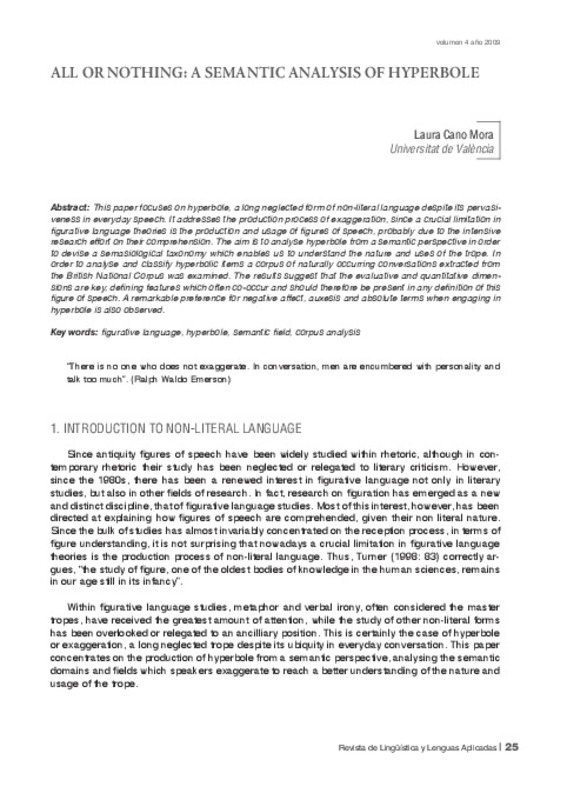JavaScript is disabled for your browser. Some features of this site may not work without it.
Buscar en RiuNet
Listar
Mi cuenta
Estadísticas
Ayuda RiuNet
Admin. UPV
ALL OR NOTHING: A SEMANTIC ANALYSIS OF HYPERBOLE
Mostrar el registro sencillo del ítem
Ficheros en el ítem
| dc.contributor.author | Cano Mora, Laura
|
|
| dc.date.accessioned | 2011-04-01T12:29:38Z | |
| dc.date.available | 2011-04-01T12:29:38Z | |
| dc.date.issued | 2009 | |
| dc.identifier.issn | 1886-2438 | |
| dc.identifier.uri | http://hdl.handle.net/10251/10645 | |
| dc.description.abstract | [EN] This paper focuses on hyperbole, a long neglected form of non-literal language despite its pervasivenessin everyday speech. It addresses the production process of exaggeration, since a crucial limitation infigurative language theories is the production and usage of figures of speech, probably due to the intensiveresearch effort on their comprehension. The aim is to analyse hyperbole from a semantic perspective in orderto devise a semasiological taxonomy which enables us to understand the nature and uses of the trope. Inorder to analyse and classify hyperbolic items a corpus of naturally occurring conversations extracted fromthe British National Corpus was examined. The results suggest that the evaluative and quantitative dimensionsare key, defining features which often co-occur and should therefore be present in any definition of thisfigure of speech. A remarkable preference for negative affect, auxesis and absolute terms when engaging inhyperbole is also observed. | es_ES |
| dc.language | Inglés | es_ES |
| dc.publisher | Editorial Universitat Politècnica de València | es_ES |
| dc.relation.ispartof | Revista de Lingüística y Lenguas Aplicadas | |
| dc.rights | Reserva de todos los derechos | es_ES |
| dc.subject | Figurative language | es_ES |
| dc.subject | Hyperbole | es_ES |
| dc.subject | Semantic field | es_ES |
| dc.subject | Corpus analysis | es_ES |
| dc.title | ALL OR NOTHING: A SEMANTIC ANALYSIS OF HYPERBOLE | es_ES |
| dc.type | Artículo | es_ES |
| dc.date.updated | 2011-04-01T11:48:32Z | |
| dc.identifier.doi | 10.4995/rlyla.2009.731 | |
| dc.rights.accessRights | Abierto | es_ES |
| dc.description.bibliographicCitation | Cano Mora, L. (2009). ALL OR NOTHING: A SEMANTIC ANALYSIS OF HYPERBOLE. Revista de Lingüística y Lenguas Aplicadas. 4:25-35. https://doi.org/10.4995/rlyla.2009.731 | es_ES |
| dc.description.accrualMethod | SWORD | es_ES |
| dc.relation.publisherversion | http://doi.org/10.4995/rlyla.2009.731 | |
| dc.description.upvformatpinicio | 25 | |
| dc.description.upvformatpfin | 35 | |
| dc.description.volume | 4 | |
| dc.identifier.eissn | 1886-6298 | es_ES |








